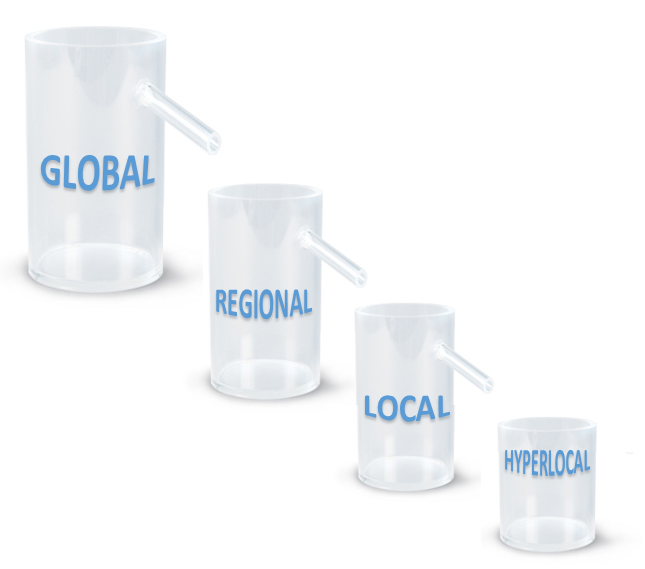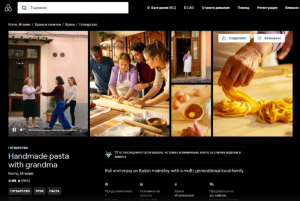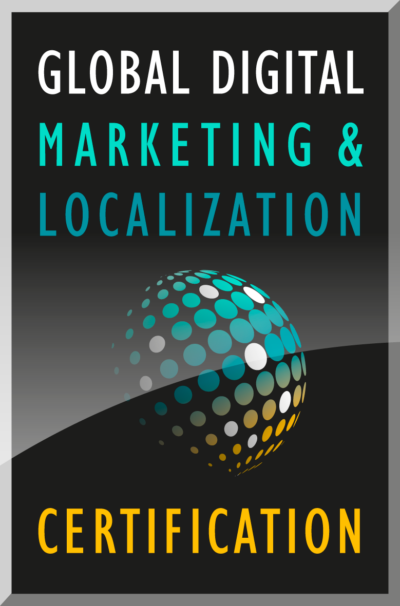This is a paper presented by Jeffrey Constantin, a recent graduate of the Global Digital Marketing and Localization Certification (GDMLC) program. This paper presents the work being produced by students of The Localization Institute’s Global Digital Marketing and Localization Certificate program. The contents of this Paper are presented to create discussion in the global marketing industry on this topic; the contents of this paper are not to be considered an adopted standard of any kind. This does not represent the official position of Brand2Global Conference, The Localization Institute, or the author’s organization.
Going global and international expansion are no longer aspirations or objectives, but rather the new norm of doing business in this global economy. From the language service provider’s perspective, this is relatively easy – you’ll often hear things such as “You can reach 90% of the online customers using only 21 languages” or “Launch multilingual websites quickly in as little as 30 days.” 
The truth is, content is everywhere and translating it is easy, but the challenge comes from managing it all in a meaningful and insightful manner which will allow your organization to not only grow internationally, but build a sustainable customer-base with whom you can engage with over time.
“Think local, act global” is a great tagline, but how do you implement this and is it the right approach for all companies? Airbnb for example is operating in more than 190 countries and their business model is driven by these pockets of local individuals that rent out their properties to the rest of the world. You could say Airbnb needs to act and think locally to expand globally. Brian Chesky (Co-Founder of Airbnb) did tell TechCrunch in 2013 that the big change that allowed Airbnb to “boom” internationally came when they opened local offices and hired local teams from within the communities they were servicing.
Companies expanding internationally are building relationships with new customers. Like any good relationship, communication is key and although customers may come looking for a product and/or service, the content (aka communication) is what keeps them engaged. The notion of global content is enticing – an easy fix – which is why it is critical to organize your content before launching any translation jobs.
Content Strategy
I am ready to go out on a limb and say that most companies produce more content than revenue. If companies have mission statements to drive their  business, they should also have content strategies that describe the planning, development and management of content. Whether that content is in English or in Portuguese, there should be a content strategy that addresses global, regional and local needs.
business, they should also have content strategies that describe the planning, development and management of content. Whether that content is in English or in Portuguese, there should be a content strategy that addresses global, regional and local needs.
There are different considerations that come into play when defining your strategy:
• Standardize vs. Localize
• Centralize vs. Decentralize
• In-sourcing vs. Outsourcing
Opting for standardization may lead to interesting cost savings and efficiency gains, but likely won’t generate the expected financial returns due to lack of engagement. The Self-Reference Criterion (SRC) effect highlights that unconsciously, we create content that aligns to our own cultural values and knowledge, which can explain why not all content translates or localizes well to other languages. After all, don’t we say language is a window into the local culture? Decentralization would certainly allow local teams to create content with the best possible cultural resonance, but this would become very costly through global expansion. Additionally, brand consistency across decentralized teams would become a considerable challenge. Either way, content does get created and the question then becomes do you need to translate every single document and video created into all languages? No, you may not need to.
Like any good recipe, I like to think that the secret is in using a blend of ingredients, while ensuring good ratios. To better illustrate this, let’s portrait the 4 levels (global, regional, local and hyperlocal) as vessels with overflow sprouts:

The idea is that you need to organize these vessels in a manner that aligns with your business goals, while finding the right balance to allow even distribution across the vessels. The overflow sprout is meant to allow your organization to avoid costly over-investments in any one of these vessels, while ensuring that each vessel plays a role in establishing overall strategy. Questions such as “Who creates content?”, “Where is content managed?” will help you organize these vessels.
From there, you can categorize components of your messaging under each vessel. Take a website for example, the user interface (UI) may be identical across all markets (global). Additionally, evergreen content such as “About Us”, “News” and “Terms & Conditions” may fall into the global vessel. The landing page may have regional content promoted via an advertisement banner (Hero). Product availability & delivery may vary per region as well, which would outline the management and translation of product SKUs. Also, content may be distinct across countries and therefore “Support”, “Contact Us” as well as “Careers” could be categorized at the local level. Finally, SEO & SEM strategies may be addressed at the Hyperlocal level as the focus here is on attracting traffic through targeted search strategies. Breaking down your content strategy into what makes sense from a global, regional, local and even hyperlocal perspective will allow you to build a content strategy that aligns to your objectives, while also ensuring scalability of content as you add more languages. Pam Didner – a digital & tech leader & author – calls out, in her book Global Content Marketing (2015) that “To scale content across regions, you need to setup communication and collaboration process between headquarters and regions.” This collaboration is a proven strategy to gain buy-in from in-country teams and build better alignment with the corporate strategy.

Let’s take this same idea and try to apply it to Apple and their Apple Watch Series 5 campaign (click country links below):



As all Apple products, its watch is a “standardized” product – it is identical across all countries. This standardization strategy also plays into how Apple engages with its customers as they follow a global strategy, where decisions are driven by HQ and each country supports the given directives. That said, it works for Apple because their target persona can be described as World Citizens – customers that have an expanded global identity with less focus on their local community. You’ll notice across all three ads that the content is identical and Apple did not even bother to translate the UI of the watch. Yet, the ad speaks to everyone. This starts with the multiculturalism of the presented personas – visually, if you were to remove the voice-over and on-screen text, it would be very difficult to determine from which market this ad originated from. The concepts presented are worldly understood: art, training, coffee break, health conscious, etc. Clearly a global approach, but Apple stays relevant to its customers by addressing local needs – this ad was localized across Apple’s core set of supported languages. It is present across all country-specific YouTube channels, which is another example of how Apple engages with the different markets. A quick glance through Apple’s multiple YouTube channels reveals that the company is not producing, but rather managing content across each country channel. Specific to the Apple Watch video, you can notice the nuances between English versions for the UK and Canada as well as French versions for Canada and France. The scripts and narrations were “translated” specifically for each country. It is interesting to note that the ads for Japan and France are longer – 2 minutes instead of the 1 minute and 9 seconds presented above. The additional footage relates to integrations with public transport services and Apple Music among other things. This could be due to agreements and enhanced functionality through app development for specific countries. Nevertheless, it is clear that Apple acts global, but is focused on enhancing regional campaigns through its digital marketing strategy.
Now Airbnb has a different challenge. Although they offer a service via their online marketplace, they have built their community by attracting individuals across the world to their platform. The persona here is different from Apple, Airbnb interacts with Glocals, individuals with both a global and local mindset. It’s a natural fit because it aligns with the business case: “I rent out my apartment or house by attracting people from elsewhere to come visit my neighborhood or country, while I myself expand my horizons elsewhere.” Localization becomes key to Airbnb as it not only allows them to expand its community, it also helps its community work better together. This is highlighted by their strategy to expand the number of languages supported on their site from 31 to 62:
You might have trouble conversing with your host to ask if they have a crib for your newborn, or whether the home is located in a quiet neighborhood. The Airbnb host, on the other hand, may struggle to communicate what they have to offer back to you. That’s why this launch is incredibly important. I believe that language understanding is at the core of empathy, and by supporting 62 languages total, we’re aiming to eliminate these kinds of barriers.
Now, although local-relevancy is strategic to Airbnb’s engagement model, they need to be able to rally their dispersed community. Their #OneLessStranger campaign is a great example of establishing a global concept, while leaving content curation to the community. In essence, #OneLessStanger was a concept launched to allow individuals around the world to perform an act of kindness by offering hospitality to a stranger and from that moment, they would take a photo or video with the person and share that via social media with the hashtag #OneLessStranger. Through this campaign, Airbnb has flipped Apple’s approach – Airbnb starts at the grassroots (local) and builds a global campaign with these stories created by their global community. This approach is also self-serving as their service becomes even more appealing because the community gains appreciation of their stay due to these random acts of kindness. #OneLessStanger was a campaign launched in 2015, but Airbnb is at it again with their latest launch, Airbnb Cooking Experiences. This new campaign launched this November allows travelers to combine cooking experiences with their stay at Airbnb locations. Airbnb hosts can now become a sort of regional celebrity by going beyond their hostess role and becoming a culinary chef, which generates incredible local (if not even hyperlocal) content for Airbnb. Here are screen shots from Airbnb’s website where you can book a stay with Nonna to make handmade pasta (click link below):


Handmade Pasta with Grandma – AirBnB (Video)
Final Thoughts
What these examples from Apple and Airbnb highlight is that going global isn’t about translating your content or the technology-stack that supports it, it’s about the strategy you put in place to engage with your customers and the global community you wish to build.
It certainly comes from a top-down mentality. One of the challenges I often encounter while working with large national and international companies is the fact that localization strategies (and budgets) are often bundled into larger marketing, product or web strategies. “Create first and translate later” is a common theme. That why it’s important to explain the impact of content. Often the focus of localization and translation departments is the cost per word and ultimately trying to reduce spend. I believe it is worth reporting on the ROI of translation – i.e. report the cost per follower for social media activity or cost per product sold when participating in global product launches. Global content should be positioned as a tool to influence sales and growth. If you want to be global, you need to engage with your customers no matter their location. Does it mean you need to support 21 languages from day-1? No. It should though mean that no matter the language, content is produced and managed to communicate with your customers globally.
“The Global Digital Marketing & Localization Certificate is the perfect crash-course for anyone getting started in the translation and localization business. I appreciated the granularity of each module as they each covered different yet relevant marketing topics, while offering insightful & valuable nuggets of information. The interviews certainly help align the concepts with business scenarios encountered by subject matter experts within the industry. This is a thoroughly crafted Localization-101 encyclopedia of knowledge.”
 If you are interested in learning more about the Global Digital Marketing and Localization Certification please click here. The program offers dual credentials, with a Certificate from the University of North Carolina Wilmington and a Certification from The Localization Institute.
If you are interested in learning more about the Global Digital Marketing and Localization Certification please click here. The program offers dual credentials, with a Certificate from the University of North Carolina Wilmington and a Certification from The Localization Institute.References
Pam Didner, Global Content Marketing, McGraw Hill Education, 2015
https://www.pamdidner.com/
https://www.forbes.com/sites/bernardmarr/2015/09/30/big-data-20-mind-boggling-facts-everyone-must-read/
https://www.forbes.com/sites/maynardwebb/2016/01/21/going-global-heres-what-you-need-to-know
https://www.youtube.com/user/Apple
https://www.linkedin.com/pulse/apple-inc-strategic-analysis-global-context-parag-deshpande/
https://www.adweek.com/brand-marketing/apple-shifts-its-marketing-strategy-to-focus-on-digital-and-regional-campaigns/
https://www.retaildive.com/news/apple-pivots-marketing-to-focus-on-digital-regional-efforts-1/436672/
https://airbnb.design/words-of-welcome/
https://techcrunch.com/video/airbnb-co-founder-on-international-growth-and-expansion/
https://fortune.com/longform/airbnb-travel-mission-brand/
https://www.thrillist.com/news/nation/airbnb-cooking-experiences
https://www.airbnb.com/experiences/55449?irgwc=1&irclid=0IARYAxxoxyOWPQwUx0Mo38XUkn3FawONTR63k0&ircid=4273&sharedid=thrillist.com&af=49497874&iratid=9627&c=.pi73.pk4273_10078&irparam1=
and of course… https://www.glasbergen.com/
Disclaimer
Copyright © 2020 The Localization Institute. All rights reserved. This document and translations of it may be copied and furnished to others, and derivative works that comment on or otherwise explain it or assist in its implementation may be prepared, copied, published, and distributed, in whole or in part, without restriction of any kind, provided that the above copyright notice and this section are included on all such copies and derivative works. However, this document itself may not be modified in any way, including by removing the copyright notice or references to The Localization Institute, without the permission of the copyright owners. This document and the information contained herein is provided on an “AS IS” basis and THE LOCALIZATION INSTITUTE DISCLAIMS ALL WARRANTIES, EXPRESS OR IMPLIED, INCLUDING BUT NOT LIMITED TO ANY WARRANTY THAT THE USE OF THE INFORMATION HEREIN WILL NOT INFRINGE ANY OWNERSHIP RIGHTS OR ANY IMPLIED WARRANTIES OF MERCHANTABILITY OR FITNESS FOR A PARTICULAR PURPOSE.











